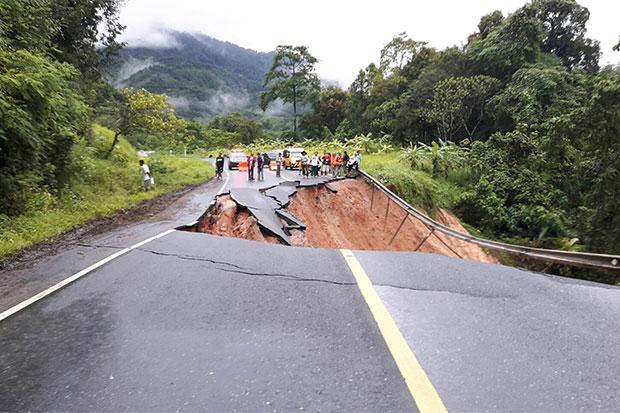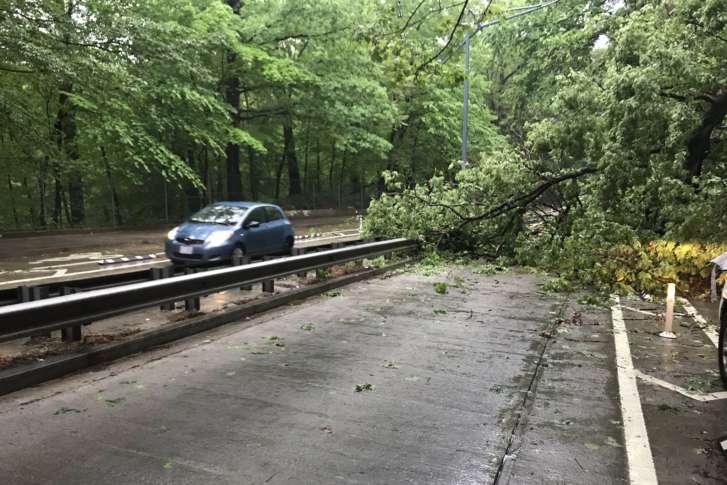Bill
Touchdown! Greaser!
- Joined
- Mar 2, 2005
- Messages
- 15,103
- Location
- Southeast Tennessee
- Display Name
Display name:
This page intentionally left blank
Computer, 1965:

Computer, 50 years later:

It will happen.


Yep... for the most part our interstate system is already somewhat autonomous friendly. It's the individual cities and suburbs that are going to require the upgrades in a uniform and universally adoptable infrastructure. This is where it can get prohibitively expensive.Interstate Highways in particular have a very well fleshed out set of standards, which makes them relatively easy in the grand scheme of things, which is why Tesla et al have gotten systems working there first for the most part.
Personal computers and their software are not the same as the systems you'd find in proprietary hardware like a car. There are Boeings flying just fine today with 20 year old processors. There are trucking fleets still rolling down the highways with 20 year old telemetrics hardware. I would bet you can still find ATM's out there with antique hardware.@flyingcheesehead
Not saying it is impossible, but IT has trouble supporting stuff from five years ago. Ten is a stretch. This is a fundamental change where you need to either support it for twenty years or require people to upgrade the HW on a regular basis.
Sent from my SM-J737T using Tapatalk
That Boeing is not connected. Neither is that truck.Personal computers and their software are not the same as the systems you'd find in proprietary hardware like a car. There are Boeings flying just fine today with 20 year old processors. There are trucking fleets still rolling down the highways with 20 year old telemetrics hardware. I would bet you can still find ATM's out there with antique hardware.
Umm... The truck most definitely is connected. That's exactly what telemetrics are and exactly what they do. Its how I know exactly where all my trucks are and what they're doing at all times. They connect directly to the vehicles J1939 buss or 1708 or 1587 on older trucks and transmit that data over the cellular network to a server.That Boeing is not connected. Neither is that truck.
I should have been more specific. Tesla directly connects the core computer to the network.Umm... The truck most definitely is connected. That's exactly what telemetrics are and exactly what they do. Its how I know exactly where all my trucks are and what they're doing at all times. They connect directly to the vehicles J1939 buss or 1708 or 1587 on older trucks and transmit that data over the cellular network to a server.
Yep... for the most part our interstate system is already somewhat autonomous friendly. It's the individual cities and suburbs that are going to require the upgrades in a uniform and universally adoptable infrastructure. This is where it can get prohibitively expensive.
As for core computer being connected to the network. If there is no connection (you can turn it off) the car still operates under normal control. So the question is the mother ship directing the car, or is it the onboard data and onboard logic? I believe it is on board but actually not sure if that will be the case at Level 4-5.
You're partially right. What we will see in the future are entire newly built suburbs and neighborhoods that are autonomous friendly. As far as re-building entire inner city infrastructures. Not going to happen! Way to expensive and the taxpayers won't stand for it.
So it never snows on city streets? I guarantee there's going to have to be some sort of magnetically activated lane striping or imbedded sensors that the cars can follow or they'll be over the road after a fresh snow fall. Same goes for the interstates. GPS systems only so accurate and can vary by as much as 10 ft...so that technology gets thrown out the window right away if you expect a "smart car" to stay in it's own lane after a fresh snow fall.Really, the hard part is going to be getting a self-driving car to use a dirt "road" in the middle of nowhere, or driving with a fresh snowfall where it's difficult to delineate where the road is. City streets aren't that hard.
So it never snows on city streets? I guarantee there's going to have to be some sort of magnetically activated lane striping or imbedded sensors that the cars can follow or they'll be over the road after a fresh snow fall. Same goes for the interstates. GPS systems only so accurate and can vary by as much as 10 ft...so that technology gets thrown out the window right away if you expect a "smart car" to stay in it's own lane after a fresh snow fall.
Most popular mousetrap 50 years ago.Computer, 1965:

Computer, 50 years later:

It will happen.
Just because you disagree, doesn't mean we're automatically asserting that every other thing will eventually happen. But yes, autonomous vehicles will happen. Soon.Seriously though. Just because one thing happens it is not logical to assert that every other thing will eventually happen.
Autonomous vehicles already exist. So do better mouse traps.Just because you disagree, doesn't mean we're automatically asserting that every other thing will eventually happen. But yes, autonomous vehicles will happen. Soon.
We have a 2017 SUBARU with "eyesight" technology which does not operate better than the human eye. For example, it will will apply FULL braking if it's "sees" a plastic shopping bar floating in the path of the car. It does not care if somebody is following closely. Same reaction to a small tumbleweed. In responding to one situation it a creates a more dangerous situation. No, it is not better than the human eye.
Also, somebody mentioned that GPS has a 10' accuracy. Not going to work very well where I live where some dirt roads aren't much more than 10' with steep drop-offs. With no sensors or lines to guide it, will it veer back and forth 5' in each direction looking for the GPS boundaries? Not yet ready for prime time.
Just because you say it doesn't make it so.Just because you disagree, doesn't mean we're automatically asserting that every other thing will eventually happen. But yes, autonomous vehicles will happen. Soon.
So it never snows on city streets? I guarantee there's going to have to be some sort of magnetically activated lane striping or imbedded sensors that the cars can follow or they'll be over the road after a fresh snow fall. Same goes for the interstates. GPS systems only so accurate and can vary by as much as 10 ft...so that technology gets thrown out the window right away if you expect a "smart car" to stay in it's own lane after a fresh snow fall.
Exactly what I've been saying! That's why for full autonomy you will have to have so-called "magic rails" to keep all these cars on track. In adverse weather, or bad road conditions where the lane striping has the potential to be hidden/covered up, that solution is embedded sensors or magnetic lane striping.Where computers fail is combing the information and determining the cues required to make the determination of where the edge of the road is, or where a rough approximation of the road is.

Here’s the data (from https://www.rita.dot.gov/bts/sites/rita.dot.gov.bts/files/publications/national_transportation_statistics/html/table_01_35.html)
Self driving cars have been on the roads, what, maybe 2-3 years? I’ll give it the benefit of the doubt and use data for 2 years only from the above. I’ll include the total highway miles for 2014 and 2015. I doubt this includes in town driving or short trips, but it will serve to illustrate the issue.
I’ll use scientific notation NeM which means N x 10 raised to the M power.
In 2014 and 2015, total highway miles driven = 6e12 (6 million million). In those 2 years, there were approximately 70,000 (7e4) vehicle fatalities. ( https://en.m.wikipedia.org/wiki/Motor_vehicle_fatality_rate_in_U.S._by_year)
So, deaths per mile for non automonous vehicles = 7e4/6e12 = 1.2e-8.
This reference https://medium.com/waymo/waymo-reaches-5-million-self-driven-miles-61fba590fafe has Waymo’s numbers for miles driven. I’ve seen estimates for uber of 1 million. So Waymo (Google) + Uber = 6e6
Deaths per mile for autonomous vehicles = 1 / 6e6 = 1.7e-7
Odds of death in self-driving / non-self-driving = 1.7e-7/1.2e-8 = 14.
So, the data to date shows that there is a chance of death 14 times higher with the self driving vehicles. That is significant.
My strong suspicion is that since the number of total miles driven by self-driving cars is so low, the death rate will likely go up and not down as these cars are exposed to more real world situations. I strongly doubt these things have had to deal with icy roads, heavy fog, storms, etc. yet. What happens when the sensors are degraded and damaged due to dirt, rocks thrown up by the vehicle in front, hail, heavy rain, mud, etc?
And the driver behind the wheel didn’t even touch the controls, so that certainly doesn’t make the case for autonomy.
My concern isn’t whether Uber thought their cars should go on the road or not. It’s clear they thought so. They were wrong. I’m usually not a fan of a lot of heavy regulation, but I don’t want me or my family to be the guinea pigs for these folks’ software quality control testing. Get these things out of the public and back into the controlled testing environment until they can be _proven_ to be at least as safe as the normal vehicles. And the heavy burden of proof is on the vendors.
Sent from my iPad using Tapatalk
Exactly what I've been saying! That's why for full autonomy you will have to have so-called "magic rails" to keep all these cars on track. In adverse weather, or bad road conditions where the lane striping has the potential to be hidden/covered up, that solution is embedded sensors or magnetic lane striping.
Here's a good article on the subject.
Where computers fail is combing the information and determining the cues required to make the determination of where the edge of the road is, or where a rough approximation of the road is.
Exactly what I've been saying! That's why for full autonomy you will have to have so-called "magic rails" to keep all these cars on track. In adverse weather, or bad road conditions where the lane striping has the potential to be hidden/covered up, that solution is embedded sensors or magnetic lane striping.
Here's a good article on the subject.
True enough. No one can really know anything until it actually happens. But what we're talking about is not impossible. With the technology that already exists, its far from impossible in fact. I see it being very similar to heavier than air powered flight. By the time December 17, 1903 rolled around, many different entities were developing and working on finding a way to make flight happen. And although no one knew quite how to do it until it actually happened, it was largely accepted by most in the scientific community that powered flight was possible based simply on what was already known and the technology that already existed. Fully autonomous vehicles are very similar in this respect.Just because you say it doesn't make it so.
I don't think anyone knows whether autonomous vehicles will turn out to be practical as the main means of transportation.
But what we're talking about is not impossible.
This is where your argument goes off the rails, in my opinion, because you're supporting it with plausibility arguments, and plausibility arguments do not justify certainty. Predicting the course of technological advancement is just not that easy.It really isn't a question of if this happen, its only a question of when.
I'd take that bet in a heartbeat! I don't care how high-tech the car is, there is just way too much "noise" out in the real world for an autonomous car to operate safely. You will have to employ some sort of guidance systems whether it be embedded sensors, smart road signs, or magnetic lane stripping to keep these cars on the proper track. Even then it's still a crap shoot. Right now it would take me about 2 minutes to disable even the most sophisticated autonomous car on the road and make it go bonkers. We have a very long ways to go yet before any of these cars are ready for prime time.So what that article basically says is that 3M is betting against the automakers and hoping to cash in when they "give up".
I'd take that bet in a heartbeat!
So do better mouse traps.





In all of those situations, the roads would be completely shut down now. And in some of them, the dust storm for instance, we may very well find that the sensors on autonomous vehicles can see through the cloud just fine and keep right on rolling safely while Arlo T Luddite drives his '72 Dart right into a pole because he can't see squat and doesn't have enough sense to slow down or stop. If you're going to mock autonomous tech, at least come up with something that's at least slightly valid.Just imagine how great life is going to be in the brave new world when you encounter these scenarios in your full autonomous hominid cargo vehicle. Either the roads will completely shut down, or the hominids are going to have a really bad day.
And we're not talking about some form of dryer lint based unlimited free energy that one guy is trying to invent in his garage here.
Just imagine how great life is going to be in the brave new world when you encounter these scenarios in your full autonomous hominid cargo vehicle. Either the roads will completely shut down, or the hominids are going to have a really bad day.
Not remotely as good as a human would.Ironically, the camera-based autonomous driving solutions will handle those a heckuva lot better than any magic magnetic roadway systems...
Agree to disagree.Not remotely as good as a human would.
Not remotely as good as a human would.
